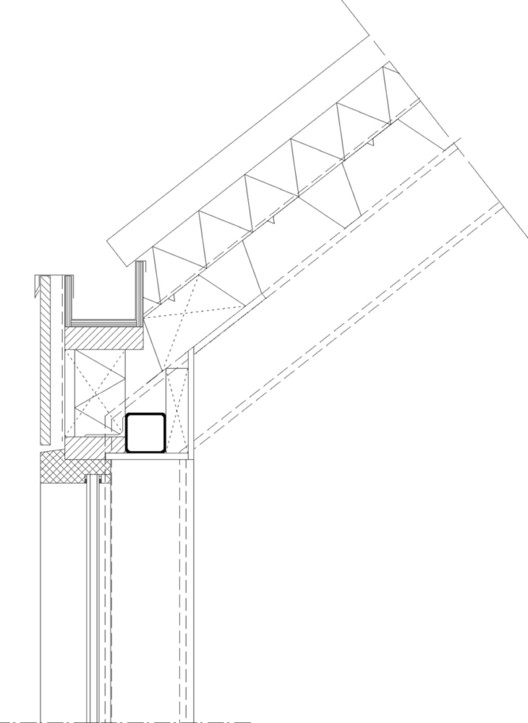
In his Robie House, Frank Lloyd Wright created an ingenious arrangement of public and private spaces that slowly moving away from the street through a series of horizontal planes. Pronounced eaves made the interior space expand toward the outside. Considered the first phase of the American architect's career, the so-called Prairie Houses had marked horizontality, mainly due to the enormous plans created by slightly inclined eaves. Eaves are ubiquitous in most traditional architecture, and in addition to their aesthetic role, they serve several important functions, the primary one being to keep rainwater away from the building's walls and structure. But for some time now, we have seen plenty of projects with sloping roofs without eaves, forming pure and unornamented volumes. This brings us to the question: in these projects, how are practical issues such as draining rainwater?

An overhang (or eave) describes the lower edge of a roof, which extends beyond the intersecting wall to form a shady space that can acquire different dimensions and appearances. In hot climates, it can be designed to stop the intense heat of the hottest months, limiting the entry of sunlight. In rainy places, it can be an intermediate space of shelter, protecting the building frame and external façade from the weather. However, eaves are not an indispensable component of a building. Many architects have designed buildings with sloping roofs without eaves, in which the archetype of the house with a gable roof takes on a simple, almost stripped, minimalist shape. It is not up to us to judge whether this design choice is functional or simply a fad. But whenever we remove this protrusion from a roof, we are faced with the challenge of avoiding problems of water infiltration and rainwater drainage. That is, without detailed and well-done construction, this design choice can be a big headache.

By examining our database of projects and its constituent construction details, we can discern a few distinct solutions to resolving these issues. These are ingenious design details which, in the eyes of the observer, appear extremely simple.
Without Gutters
Perhaps the simplest way to drain water, without gutters or other components, is how Bokarev Architects did so in their Double House project. In this case, a metal sheet was installed over the roof and on the sides of the facade. In this way, the water could not break the outer covering, keeping the building watertight. As it does not contain a gutter, there is the drawback that, in the event of a heavy rain, all the water comes down close to the walls.

Minimum eaves

Another solution, which is quite common, is to create a minimal overhang, containing a small chute to drain the water. House Karlsson by Tham & Videgård Arkitekter, as well as Haus Für Julia Und Björn and Holler House by Innauer-Matt Architekten, all employ what could be characterized as traditional eaves, but with reduced dimensions. The gutters direct the water to descent pipes, making the flow process efficient. In these cases, the gutters are located on the outside of the wall, making them accessible for cleaning. In the event of a clog, this placement also causes less damage to the structure.

Hidden gutters


However, the hidden gutter is possibly the architect's favorite solution. Due to an optical illusion caused by the observer's angle, it is very difficult to observe the discontinuity of the gutter coating in a hidden gutter, intriguing the most attentive viewers. In the Studio Zero85 project, formal purity is inspired by the barns and homes dotting the area. The façade and roof of the structure are covered with tiles, making the slight trough in the tile blanket go unnoticed. In the MiCasa projects by Stephen Davy Peter Smith Architects and Dentist with a View by Shift architecture urbanism, the gutter is a little more pronounced, but still discreet. Elsewhere, in the Riel Estate project by Joris Verhoeven Architectuur, the gutter, although almost hidden, also marks the change in coating materials between two planes.

Incorporating exterior cladding

Another widely used device is to incorporate an external, permeable skin that envelops the system, causing water to flow through a lower material, which is usually a metal tile or an impermeable cover. In the Les Coccinelles Nursery School / SOA Architectes project, it is easy to understand the solution through the gif below.
A similar solution is adopted at the Bergmeisterwolf architekten Rooftops Twin House H, 142 South Street / Sandy Rendel Architects, and GRX Arquitectos' Calixto House, which displays an incredible facade of rough stones. In these cases, a gutter is included in the solution, directing all the water collected by the inclined planes to an appropriate portion of the plot. But the presence of the gutter can be dispensed with, as noted in the Théâtre d'eau Swimming Pool / LOG Architectes project.


Whatever the design adopted, it is important that the designer is aware of the challenges imposed by a solution that seems so simple. It is also essential that the drawing is well done and carefully executed, so as to avoid future problems of infiltration or humidity that would be quite complex to solve after the building is occupied. As Mies van der Rohe said, "God is in the details."












